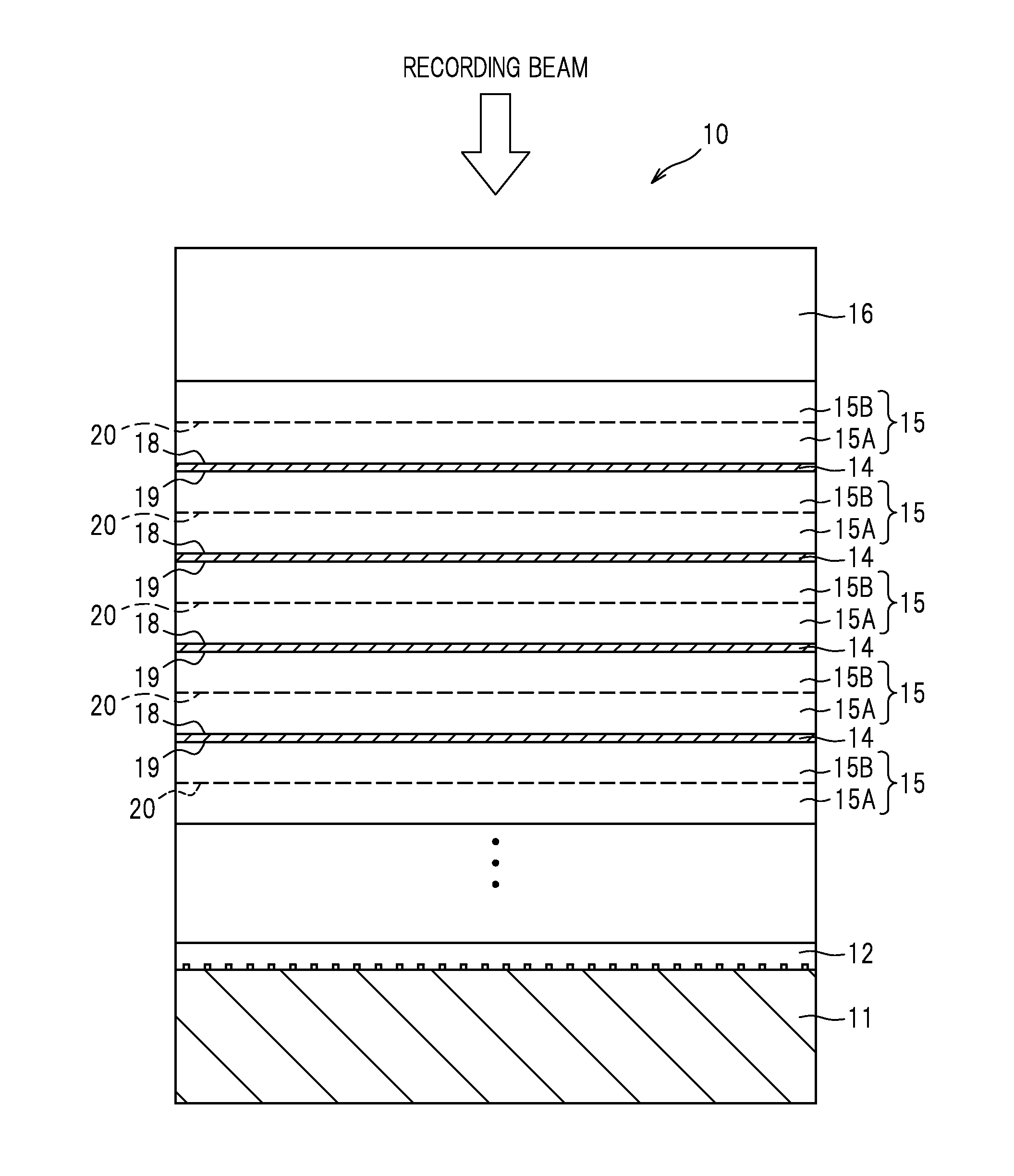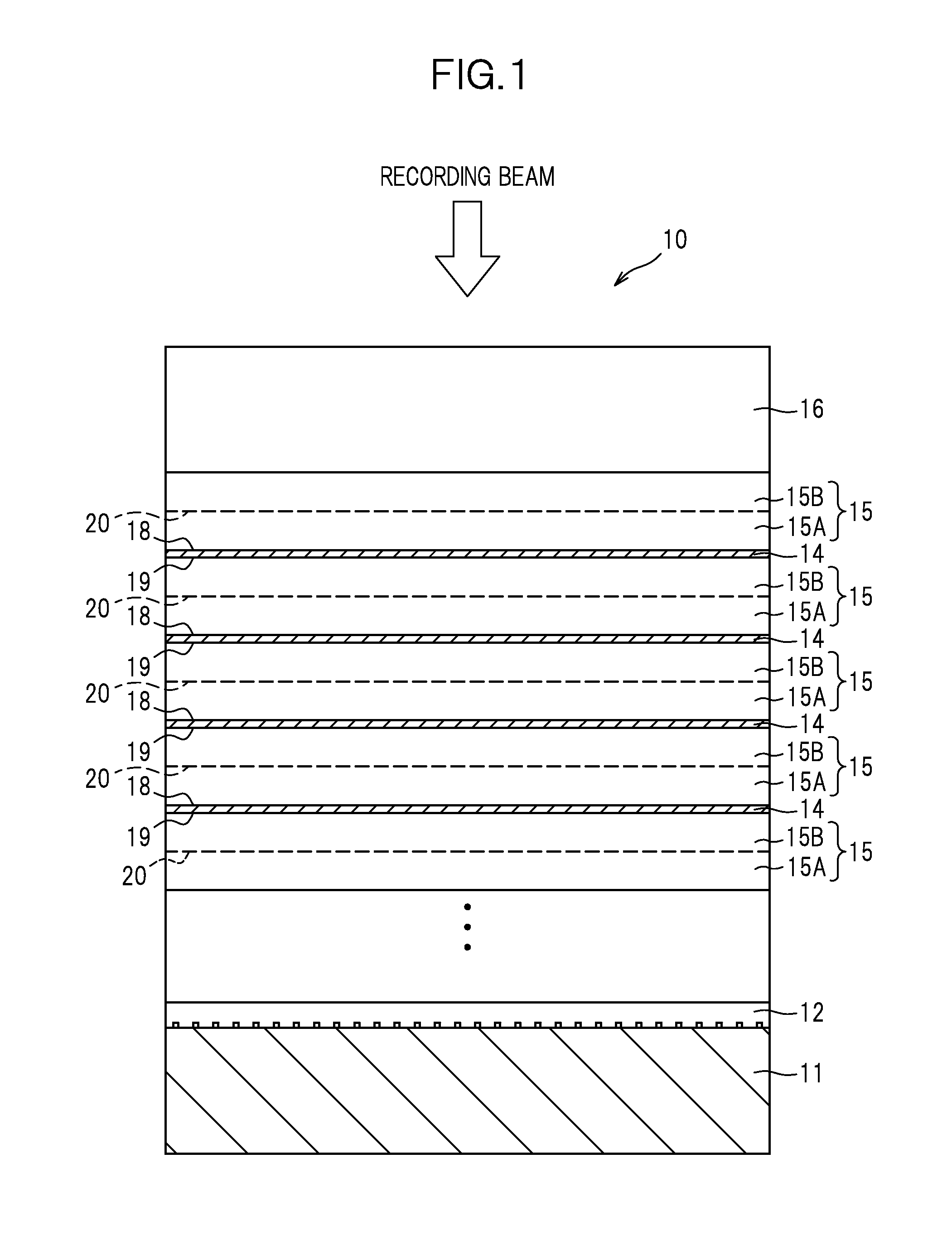Optical information recording medium and method for recording information in optical information recording medium
a technology of optical information and recording medium, which is applied in the direction of optical recording/reproducing/erasing methods, two photon recording, instruments, etc., can solve the problems of low recording sensitivity, low light absorption efficiency of multi-photon absorption compounds, and difficulty in increasing the two-photon absorption cross-section, etc., to achieve improved recording sensitivity and high sensitivity , the effect of efficient reaction
Active Publication Date: 2014-01-30
FUJIFILM CORP
View PDF21 Cites 10 Cited by
- Summary
- Abstract
- Description
- Claims
- Application Information
AI Technical Summary
Benefits of technology
The present invention is about an optical information recording medium that uses a dye that can be subject to both multi-photon absorption and linear absorption. By dispersing the dye in a polymer binder, the recording layer can be deformed when exposed to the recording beam, and information can be recorded with high sensitivity. The use of a single dye that can perform both functions allows for improved recording sensitivity and flexibility in the choice of recording materials. Additionally, the dye should have linear absorption of the recording beam not more than 5% per recording layer to allow for increased recording layers in multi-layered media.
Problems solved by technology
However, multi-photon absorption compounds are poor in the light (multi-photon) absorption efficiency and thus lower in the recording sensitivity than one-photon absorption compounds which have been widely and practically used as a recording material for the optical information recording medium.
However, increasing the two-photon absorption cross-section is technically difficult, and it is thus difficult to greatly increase the absorption efficiency.
On the other hand, increasing the concentration of the multi-photon absorption dye has limitations placed by the solubility of the dye and this may possibly cause adverse effect due to interaction with other components.
Therefore, it is difficult to greatly increase the sensitivity.
Method used
the structure of the environmentally friendly knitted fabric provided by the present invention; figure 2 Flow chart of the yarn wrapping machine for environmentally friendly knitted fabrics and storage devices; image 3 Is the parameter map of the yarn covering machine
View moreImage
Smart Image Click on the blue labels to locate them in the text.
Smart ImageViewing Examples
Examples
Experimental program
Comparison scheme
Effect test
example 1
[0127]
Solventmethyl ethyl ketone (MEK) 7 gDyeCompound A167 mgPolymer binderpolyvinyl acetate (PVAc)500 mg(from Across Co., Ltd.; Mw: 101600)
example 2
[0128]Conditions were the same as those of Example 1, except that the dye was changed as follows:
DyeCompound A143.5 mg
example 3
[0129]Conditions were the same as those of Example 1, except that the dye was changed as follows:
DyeCompound A67.5 mg
the structure of the environmentally friendly knitted fabric provided by the present invention; figure 2 Flow chart of the yarn wrapping machine for environmentally friendly knitted fabrics and storage devices; image 3 Is the parameter map of the yarn covering machine
Login to View More PUM
| Property | Measurement | Unit |
|---|---|---|
| thickness | aaaaa | aaaaa |
| thickness | aaaaa | aaaaa |
| thickness | aaaaa | aaaaa |
Login to View More
Abstract
An optical information recording medium 10 comprises a plurality of recording layers 14, and intermediate layers 15 each provided between the recording layers 14. Each of the recording layers 14 includes polymer binder and dye dispersed in the polymer binder, and the dye is subject to multi-photon absorption of a recording beam RB having a predetermined wavelength and to linear absorption not smaller than 1.5% per recording layer at the predetermined wavelength of the recording beam. When the dye is irradiated with the recording beam and generates heat by linear absorption and multi-photon absorption of the recoding beam RB, the polymer binder undergoes a change of shape by the generated heat, whereby an interface between the recording layer 14 and the intermediate layer undergoes a change of shape to record information.
Description
CROSS-REFERENCE TO RELATED APPLICATION(S)[0001]This application is a continuation application of International Application No. PCT / JP2011 / 072394 filed on Sep. 29, 2011, which claims priority to Japanese Patent Application No. 2011-070029 filed on Mar. 28, 2011, the disclosures of which are incorporated herein by reference in their entireties.TECHNICAL FIELD[0002]The present invention relates to an optical information recording medium and a method for recording information in an optical information recording medium.BACKGROUND ART[0003]In order to increase recording capacity of an optical information recording medium, attempts have been made on the optical information recording medium to laminate recording layers into a multi-layered structure. As optical information recording media which have been put into practical use for recording information in a plurality of recording layers, write-once digital versatile disks (DVDs) and write-once Blu-ray discs (registered trademark) are alread...
Claims
the structure of the environmentally friendly knitted fabric provided by the present invention; figure 2 Flow chart of the yarn wrapping machine for environmentally friendly knitted fabrics and storage devices; image 3 Is the parameter map of the yarn covering machine
Login to View More Application Information
Patent Timeline
 Login to View More
Login to View More Patent Type & Authority Applications(United States)
IPC IPC(8): G11B7/246G11B7/24038
CPCG11B7/246G11B7/00452G11B7/24038G11B7/245G11B2007/00457
Inventor MOCHIZUKI, HIDEHIROSASAKI, TOSHIOAKIBA, MASAHARU
Owner FUJIFILM CORP
Features
- R&D
- Intellectual Property
- Life Sciences
- Materials
- Tech Scout
Why Patsnap Eureka
- Unparalleled Data Quality
- Higher Quality Content
- 60% Fewer Hallucinations
Social media
Patsnap Eureka Blog
Learn More Browse by: Latest US Patents, China's latest patents, Technical Efficacy Thesaurus, Application Domain, Technology Topic, Popular Technical Reports.
© 2025 PatSnap. All rights reserved.Legal|Privacy policy|Modern Slavery Act Transparency Statement|Sitemap|About US| Contact US: help@patsnap.com



